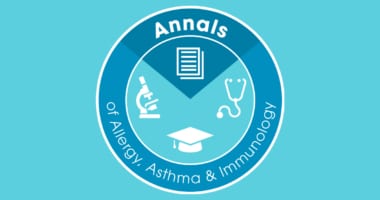 It is amazing that 2019 is already upon us. The contents of this month’s Annals of Allergy, Asthma and Immunology feature an emphasis on our old friend, chronic rhinosinusitis. Those of us who see patients regularly are faced with increasingly severe presentations of this family of diseases as the more straightforward nasal symptoms are increasingly cared for by primary care providers and/or patient self-management. Accordingly, we have multiple articles that focus on more severe presentations that should help our readers better care for these patients. There are a couple of articles I would like to call to your attention.
It is amazing that 2019 is already upon us. The contents of this month’s Annals of Allergy, Asthma and Immunology feature an emphasis on our old friend, chronic rhinosinusitis. Those of us who see patients regularly are faced with increasingly severe presentations of this family of diseases as the more straightforward nasal symptoms are increasingly cared for by primary care providers and/or patient self-management. Accordingly, we have multiple articles that focus on more severe presentations that should help our readers better care for these patients. There are a couple of articles I would like to call to your attention.
The first is a review on the microbiome of the nose by Matthew Rawls, BScH, and Anne Ellis, MD, MSc, FACAAI, from Ontario. In their article, they describe the basics of the microbiome and provide excellent background information for those familiar with the concept but not details. They expand the hygiene hypothesis to include the impact of the microflora and biodiversity which can account for different microbiomes in different individuals. Finally, they describe the similarities and differences between the nasal microbiome of normal and healthy versus allergic rhinitis individuals. This information will orient the reader for future articles that explore the role of the nasal microbiome in pathophysiology, as well as how manipulating the microbiome may have clinical potentials such as the therapeutic possibilities for probiotics in allergic rhinitis.
Another article of considerable interest is from Ulrich Wahn, MD, PhD, and his group from Germany, describing findings of a 20-year observational study of the natural history of developing allergic diseases in the first 20 years of life. Over 1,300 children were enrolled in this study that sought to identify the effects of various environmental and lifestyle influences on the development of allergic rhinitis. This study has a modern-day precision medicine approach as the family history (genetic influence) was a strong predictor of the enrollee’s risk for developing asthma during the 20-year observation period. This study confirms and extends long-held opinions regarding risk factors for developing allergic disease in childhood and offers a renewed basis for interventional research to reduce or eliminate these risks in various subpopulations.
I hope you find these and other articles of interest and utility. As always, I welcome comments and feedback. Remember, should you wish to comment for possible publication about a specific article in Annals, feel free to directly email me your comments (500 words max). I look forward to hearing from many of you.
Gailen Marshall Jr., MD, PhD, FACAAI
Editor-in-chief

